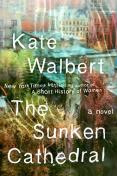BKMT READING GUIDES
The Sunken Cathedral: A Novel
by Kate Walbert
Hardcover : 224 pages
0 club reading this now
0 members have read this book
Introduction
From the National Book Award nominee and author of the acclaimed, New York Times bestselling A Short History of Women, a deeply moving, “lyrical, ominous, and unexpectedly funny” (Tom Perrotta, author of The Leftovers) novel that follows a cast of characters as they negotiate one of Manhattan’s swiftly changing neighborhoods, extreme weather, and the unease of twenty-first-century life.
Marie and Simone, friends for decades, were once immigrants to the city, survivors of World War II in Europe. Now widows living alone in Chelsea, they remain robust, engaged, and adventurous, even as the vistas from their past interrupt their present. Helen is an art historian who takes a painting class with Marie and Simone. Sid Morris, their instructor, presides over a dusty studio in a tenement slated for condo conversion; he awakes the interest of both Simone and Marie. Elizabeth is Marie’s upstairs tenant, a woman convinced that others have a secret way of being, a confidence and certainty she lacks. She is increasingly unmoored—baffled by her teenage son, her husband, and the roles she is meant to play.
In a chorus of voices, Kate Walbert, a “wickedly smart, gorgeous writer” (The New York Times Book Review), explores the growing disconnect between the world of action her characters inhabit and the longings, desires, and doubts they experience. Interweaving long narrative footnotes, Walbert paints portraits of marriage, of friendship, and of love in its many facets, always limning the inner life, the place of deepest yearning and anxiety. The Sunken Cathedral is a stunningly beautiful, profoundly wise novel about the way we live now.
Editorial Review
Guest Review by Ann Packer


Kate Walbertâ??s brilliant fiction has always been full of contradictions. Itâ??s delicate but bold. Sweepingly historical but deeply intimate. Leisurely yet absolutely gripping. In her new novel The Sunken Cathedral, she gives us her most complex and moving novel to date, a story of intersecting lives in Manhattan and of the ever-difficult negotiations we make with memory and yearning.
Itâ??s the near future. Weather patterns have gone haywire, and the city and its residents are bracing for the worst, enduring constant rain and ever fearful of catastrophic flooding. Marie and Simone are elderly widows, still plucky enough to enroll in an art class but bewildered by the losses theyâ??ve incurred and by the mysteries surrounding love in its many forms. Marie rents the upper floor of her house to a family of three, a woman named Elizabeth and her husband and son, whose attendance at a local school raises such anxieties for Elizabeth that she becomes consumed by self-doubt, which has repercussions that are minor for the main characters but catastrophic for one man whom we--and they--only glimpse.
This is Walbertâ??s genius: to reveal the threads that stretch from person to person, from present to past, and in so doing expand her story into new and unexpected dimensions. No writer working today matches her ability to find the universal in the exceedingly particular, as when Marie, remembering the central trauma of her childhood in war-torn France, which played out in an orchard after dark, imagines that again (or still) â??she smells the sick sweet of apricots, feels the soft rotten fruit on her bare feet.â??
Walbertâ??s tactic in this book is at once simple and breath-taking: she uses footnotes. A paragraph about Marieâ??s late husband ends with an asterisk that takes us to a footnote that begins this way: â??Marie finds it almost unbearable that Abe is dead and she is alive,â?? hardly an afterthought, hardly irrelevant, but its placement at the bottom of the page perfectly represents the ideaâ??s position in Marieâ??s mind: itâ??s at the base of everything. As the novel progresses, footnotes take us deeper into the charactersâ?? memories, elaborating on and offering counterpoint to the main text. A device that in the work of other writers often seems an affectation finds in The Sunken Cathedral, something like an ideal use. â??There is this,â?? Walbert seems to be saying in the main text, and then she drops you to the bottom of the page and says: â??But be aware, there is also this.â??
After a member of the art class has died unexpectedly, the teacher tries to coax the class into a minute of silence, saying â??â??We are here to remember our good friend and fellow artistâ??â?? and then stopping, because of course the students are not there for that, they are there to paint, to â??see in the way one must see to be alive. We are here, then, to be alive,â?? he thinks. â??To live.â?? Kate Walbert sees in a manner that exalts the everyday into poetry and gives our deepest desires an unexpected and brilliant expression. She is among our very best writers, which The Sunken Cathedral makes abundantly clear.
Discussion Questions
No discussion questions at this time.Book Club Recommendations
Recommended to book clubs by 0 of 0 members.
Book Club HQ to over 90,000+ book clubs and ready to welcome yours.
Get free weekly updates on top club picks, book giveaways, author events and more








